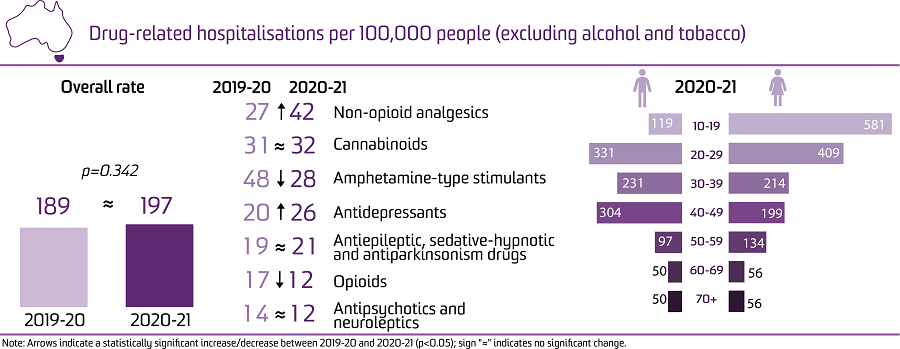2 Nov 2022
Drug Trends output:
Trends in drug-related hospitalisations in Tasmania, 1999-2021
Trends in drug-related hospitalisations in Tasmania, 1999-2021
.cropimg.width=335.crop=video.png)
Key findings

This summary report presents findings on all drug-induced deaths (i.e., overdose and other drug-induced deaths where drugs have been deemed the underlying cause of death) in Tasmania from 1999-00 to 2020-2021.
There were 1,009 hospitalisations with a drug-related principal diagnosis in Tasmania in 2020-21.
This is equivalent to 197 hospitalisations per 100,000 people, which was not significantly different from the rate in 2019-20 (189 hospitalisations per 100,000 people; p=0.342) but higher than reported in 1999-00 (127 hospitalisations per 100,000 people).
These findings are part of the national report Trends in drug-related hospitalisations in Australia, 1999-2021.
Our public online data visualisation allows viewers to disaggregate data in different ways, and to download these images for their own use.
Chrzanowska, A., Man, N., Akhurst, J., Sutherland, R., Degenhardt, L. & Peacock, A. (2022). Trends in drug-related hospitalisations in Australia, 1999-2021. Sydney: National Drug and Alcohol Research Centre, UNSW Sydney. DOI: 10.26190/wrsv-3b78
We acknowledge the Australian Institute of Health and Welfare and jurisdictional data custodians for the provision of data from the National Hospital Morbidity Database.
The Drug Trends program is funded by the Australian Government Department of Health and Aged Care under the Drug and Alcohol Program.
Please note that any representation of these data should include an acknowledgment of Drug Trends at the National Drug and Alcohol Research Centre, University of New South Wales.
©NDARC, UNSW SYDNEY 2022
This work is copyright. You may download, display, print and reproduce this material in unaltered form only (retaining this notice) for your personal, non-commercial use or use within your organisation. All other rights are reserved. Requests and enquiries concerning reproduction and rights should be addressed to the information manager, NDARC, UNSW Sydney, NSW 2052, Australia via drugtrends@unsw.edu.au.
2 Nov 2022
National Illicit Drug Indicators Project (NIDIP) reports
Download this resource
Contact
Research areas
The rate of hospitalisations was higher among females than males in 2020-21 (241 versus 163 hospitalisations per 100,000 people).
In 2020-21, the rate of hospitalisations was highest among the 20-29 age group, followed by the 10-19 and 40-49 age groups (429, 285, and 263 hospitalisations per 100,000 people, respectively). Among males, the rate of drug-related hospitalisations was highest in the 20-29 age groups, and among females in the 10-19 age groups.
The highest number and rate of hospitalisations in 2020-21 was observed in inner regional Tasmania (747 hospitalisations, 206 per 100,000 people; noting there are no major city areas in Tasmania).
In 2020-21, 48% of drug-related hospitalisations in Tasmania were due to drug poisoning. Furthermore, 82% of drug poisoning related hospitalisations were intentional (78 hospitalisations per 100,000 people) and 11% were unintentional (9.2 hospitalisations per 100,000 people).
In 2020-21, the rate of hospitalisations was highest where there was a principal diagnosis indicating non-opioid analgesics (42 hospitalisations per 100,000 people).
Compared to 2019-20, there were significant decreases in 2020-21 in the rates of hospitalisations related to amphetamine-type stimulants and opioids (p<0.050).
In contrast, there were significant increases in the rate of hospitalisations related to non-opioid analgesics and antidepressants (p<0.050).
Age-standardised rate per 100,000 people of drug-related hospitalisations, by sex, Tasmania, 1999-00 to 2020-21.
Provision of Tasmanian data between 2008-09 and 2015-16 was limited to drug related hospitalisations based on selected drug-related ICD-10-AM codes (see the methods for the list of ICD-10-AM codes). Estimates of drug-related hospitalisations for this period are likely to be underestimated.
Age-standardised rate per 100,000 people of drug-related hospitalisations, by remoteness, Tasmania, 2012-13 to 2020-21.
Note: The size (area) of the bubble is proportional to the number of hospitalisations. Data on remoteness are only available from 2012-13. There are no major city areas in Tasmania. Where the number of hospitalisations for remote and very remote Tasmania were small (less than or equal to 10) age-standardised rates were not calculated. Please refer to our methods document for details.
Age-standardised rate per 100,000 people of drug-related hospitalisations, by principal diagnosis of mental and behavioural disorder due to substance use (A) and external cause of poisoning (B), Tasmania, 1999-00 to 2020-21.
Age-standardised rate per 100,000 people of drug-related hospitalisations, by drug identified in the principal diagnosis, Tasmania, 1999-00 to 2020-21.
Note: Age-standardised rates were not calculated if the number of hospitalisations was less than or equal to 10 (please refer to our methods document for details). Suppressed data are visible as gaps in the data series.